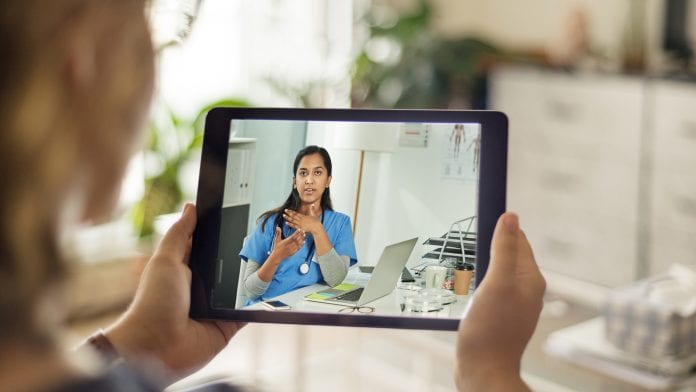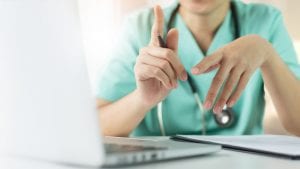
Rachel Young, of Sheffield Hallam University, explains how clinical care could be modified to better support those recovering from long COVID.
Long COVID, or post-COVID syndrome, is thought to be affecting millions of people around the world. For some, the long-haul symptoms of the disease can be debilitating, affecting not only their physical health but mental wellbeing, too. In a bid to support those dealing with the prolonged effects of COVID-19 and find out more about what treatment pathways could be effective, Sheffield Hallam University launched the Research and Innovation for post Covid-19 Rehabilitation unit. The so-called RICOVR unit aims to glean knowledge from a broad spectrum of academic experts, including those from behavioural science to robotics, in order to establish programmes and products that can support the recovery of those experiencing long COVID. It will also provide healthcare providers with valuable feedback into the effectiveness of rehabilitation programmes that could, in turn, become a scalable solution to support long COVID sufferers. Working in partnership with the National Centre for Sport and Exercise Medicine (NCSEM), Darnall Well Being (DWB) and Sheffield Hallam University’s Advanced Wellbeing Research Centre (AWRC), a series of virtual rehab clinics were created to explore the feasibility of remote clinical care and welcome those from the surrounding community to discuss their experiences of living with long COVID. The project highlighted not only the diagnostic ambiguity around the disease but also the secondary consequences of prolonged symptoms. To find out more, Health Europa Quarterly’s (HEQ) editor, Lorna Malkin, spoke to Rachel Young who was part of the clinical care team working on the virtual clinics project.
What are the key challenges currently facing the management and treatment of long COVID?
One of the main challenges stems from the diagnostic uncertainty surrounding long COVID. People are reporting a range of symptoms and these symptoms do not always seem to pull together in a logical way. We have seen a combination of cardiac changes, breathlessness, and palpitations, combined with things like unexplained bruising. Some symptoms seem to be sustained from the original COVID infection, such as long-term breathlessness or a persistent cough, or even persistent headaches. But then, people are also reporting the onset of new symptoms. Following the first wave of acute illness things might settle down, but then after a few weeks they are noticing new symptoms which may be associated with the infection, but we cannot be sure.
Long-COVID symptoms can be so diffuse so from a medical point of view it is really difficult to decide what tests to run. For therapy teams and support teams, the challenge is the unknown and concerns about possibly making a patient’s condition worse if not treated correctly. There are many diverse opinions, for instance, around exercise versus rest, everybody wants to get it right, we would always want to help people to improve and return to some sort of normality. What we saw with our project was that most people do have some sort of health history so it was important to consider to what extent that might be featuring. We had a number of female participants aged from late 30s to early 60s, some of whom are likely to be experiencing some hormonal changes during that time of their life, particularly menopause. Some of the symptoms associated with menopause – fatigue, memory changes, sleep disturbance – are also associated with long COVID. The virtual rehab clinics enabled us to gain a detailed picture of a patient’s health and to really understand what their trajectory of health has been in the run up to COVID, and what their experiences are with it now.
Can you tell me about your involvement with the University’s RICOVR unit and how it is supporting people suffering from long COVID?
My involvement with RICOVR has mainly been through the long COVID virtual clinics project. The unit has also created an app to help people monitor their symptoms and input their activity, therefore enabling them to make more informed judgments about what their optimal levels of activity might be and recognise any correlating patterns in their symptoms. The app is tailored to each individual’s pathway, which is important with COVID since everyone’s experience of it is unique. There are a lot of resources and support services available through the RICOVR website and a number of ongoing projects to support people’s recovery.
Can you tell me about your role in the virtual research clinics and the key objectives of the project?
I am a physiotherapist by background and my clinical expertise is as a neurological physiotherapist. Whilst very different, there are some parallels between what the neurological population experience and what people with long COVID are reporting. I was able to transfer some of those skills from my clinical experience into helping to shape the protocol and the intervention for this project. I was also directly involved in supporting some of the participants through the virtual clinic sessions. One of the objectives of the clinic was to reach into an underserved community to find those individuals who might struggle to come forward to NHS services or the support services. We worked very closely with Darnall Well Being (DWB) who are a local community support service and helped us find participants for the programme.
Our overarching goal was to explore the feasibility of a virtual model of clinical delivery and to understand the challenges that people faced when navigating the effects of long COVID. Participants were asked to complete questionnaires regarding their symptoms before partaking in three sessions with a doctor and therapist. We wanted to support their recovery back to what might be a more normal way of life but more than that, we wanted to know how they found their experience of remote, virtual care and if virtual sessions were something they were likely to sign up to and attend.
Have you faced any unexpected challenges or setbacks over the course of this research project?
I have been aware of similar services that, whilst people are really struggling with long COVID, they often do not come forward to those opportunities, so recruitment felt slow during those early weeks. We did manage to get the number of participants that we wanted, and many committed to all three sessions which is encouraging. Likewise, I think some people would have been very willing to continue those virtual sessions if offered.
For some participants who had not used this type of media before the session felt a bit strange for them, there was definitely a difference across the participants in terms of their digital literacy and how comfortable they felt with the mode of conversation. What we certainly saw was that people adjusted to it.
There were some people that even with that offer of support still decided against it just because they could not imagine meeting a doctor and a therapist via video. If you had not used this technology, for whatever reason, then I think it is a really hard thing to visualise.

Our overarching goal was to explore the feasibility of a virtual model of clinical delivery and to understand the challenges that people faced when navigating the effects of long COVID.
Do you think further support or funding is needed to develop a comprehensive global response to the effects of long COVID?
I do because it is a long-term condition. What we saw with our participants was that some of them are living just above the critical threshold in terms of coping with the demands of family life and running their household, jobs, and incomes etc. Their experience of long COVID was really putting them in a situation where they were dipping under that threshold, they were no longer coping. We know it is a persistent condition, but we do not know what its longevity is going to be. If people are living with these changes for months, potentially years, then the impact upon their long-term health and their long-term wellbeing – their life situation, life circumstances, solvency – will be devastating.
A few of the participants spoke about the impact it was also having on their children and their ability to parent, so we are seeing it, not just for the people directly affected, but cascading into the generation underneath them. A few of the participants also mentioned weight gain over the last year because their lives have become much more sedentary, and they feel more fatigued. We therefore see the secondary consequences of weight gain and a sedentary life as well as the psychological effects of living with fatigue, pain and not being able to fulfil life roles in terms of family and employment. We need to continue to understand what the challenges are and move forwards in terms of identifying what sort of therapies and approaches are going to really help people to make lots of small, but important changes and essentially to bring them back to that threshold of what is a more acceptable and functional lifestyle.
During the first and second virtual sessions, which collectively lasted up to 90 minutes, we really started to understand what was happening to the participants and started to talk about what might help. These lengthier consultations meant people felt invested in and valued, there was not a 10-minute timer on the clock, and they had the ear of trusted professionals who were non-judgmental, and, to some extent, anonymous to them. The intervention was very basic and very sustainable but the conversation that was wrapped around was very complex. It felt like a real investment in that person’s wellbeing.
I think certainly scaling up the virtual model or looking at building that bridge between healthcare and third sector services is important so that we can help people in that transition. If you have been through a round of investigations through the NHS and it has been taken as far as it can, what happens then? Just because you have had an all clear from your GP or a prescription that is working and keeping you medically safe and stable, it does not necessarily mean that you are ready to get back to your normal activities without something that is just a bit more tailored. This could involve a longer conversation about your concerns and your barriers, something that supports you in preparation for that. It did feel like this clinic represented that stepping stone, which I think is needed, not just for long COVID but for a whole range of people who experience long term or fluctuating health changes.
Rachel E Young (MSc, BSc (hons) MCSP)
Programme Co-lead
Neurological Rehabilitation Research and Innovation Programme
Advanced Wellbeing Research Centre
Sheffield Hallam University
www.shu.ac.uk
This article is from issue 18 of Health Europa. Click here to get your free subscription today.








